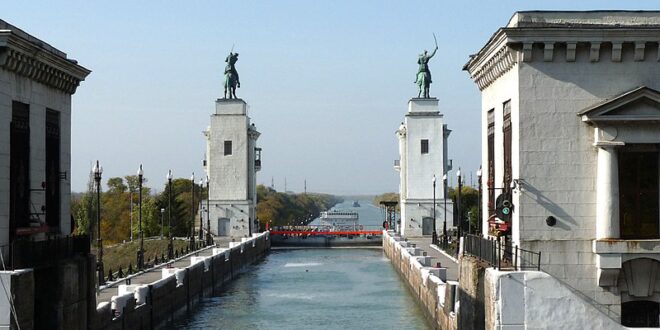In moves that may prove more consequential than Tehran’s ongoing supply of drones to the Russian army, the Iran Marine Industrial Company is currently repairing a Russian ship that crashed into ice on the Volga River and is joining China in helping Russia to dredge the Volga-Caspian Seaway Canal (see EDM, November 1, 2022; Casp-geo.ru, January 5).
The dredging of the canal will allow Russian, Chinese, Iranian, Indian and other cargo ships to carry more heavy shipments to and from the Caspian to Europe (see EDM, November 14, 2022). Furthermore, this will allow the transit of additional larger naval vessels from Russia’s Caspian Flotilla to the Sea of Azov, where Moscow can use them against Ukraine (see EDM, May 31, November 27, 2018; Dredging Today, February 16, 2022; Casp-geo.ru, February 20).
For Iran, as well as China, involvement in this effort is geo-economically and geopolitically beneficial because it will help Russia overcome some of the bottlenecks that plague both its existing infrastructure and Moscow’s ability to address these problems on its own. But perhaps more importantly, this dredging operation will further strengthen the emerging Moscow-Tehran axis, integrate Iran into the Russian-Chinese alliance, counter Turkish and Western influence in the region, as well as threaten Ukraine (see EDM, March 24, 2020; February 25, June 3, 2021). However, Moscow’s willingness to allow Tehran to join China in dredging the Volga-Caspian Seaway Canal is if anything even more crucial as it integrates Iran into the Russian-Chinese alliance in the military and economic spheres (see EDM, February 13).
The Kremlin’s decision to involve Iran in the dredging project came earlier this week and comes on the heels of two other decisions, one allowing Chinese dredging companies to take part in this operation and the other allowing Tehran to use its own ships in the Volga-Caspian Seaway Canal (Rosmorport.ru, March 11, 2022; see EDM, November 14, 2022). The two Russian government agencies involved, the Russian Sea and River Fleet Authority and Russian Port Authority, say that Iran’s involvement will allow the Russian authorities to deepen the canal to 4.5 meters (Casp-geo.ru, February 20). At present, Russian officials maintain that the canal is 3.5-meters deep. However, they also acknowledge that, in many places, silting has reduced the depth still further and, as a result, ships that could traverse the canal at that depth cannot use it during periods of the year when water coming into the canal is reduced, thus diminishing its economic and military significance (see EDM, August 6, 2020; May 10, 2022). If the current effort does succeed in deepening the canal to 4.5 meters along its entire route, almost all categories of ships in the Caspian Sea will then be able to shift to the Sea of Azov and the Black Sea, something Moscow has long desired (see EDM, November 27, 2018; August 16, 2022).
Beyond the technical considerations, analysts in Moscow are most excited about the growth and expansion of the Caspian as a trade route between Russia and Iran while helping their country solidify its ties with Iran, India and China—and even end-run Western sanctions. Some commentators are even describing such a development as a potential path toward the reordering of international trade (Ru.valdaiclub.com, February 17). More immediately, they are talking about the ways in which trade between Russian and Iran via the Caspian can overcome some of the problems created by instability in the South Caucasus and the limitations of railways in Central Asia (Realtribune.ru, November 30, 2022).
But even the most enthusiastic of analysts acknowledge that real problems are looming and that, even if the Volga-Caspian Seaway Canal is deepened, it may not provide the economic boost they forecast. They point out that Iran does not possess enough ships, especially roll-on/roll-off vessels, to make much of a difference and that Astrakhan Port, the most natural place for ships heading to the canal, is not ice free year-round. The alternative of using the Port of Makhachkala in Dagestan makes a rail route, rather than a canal route, more economically viable. Further, they suggest that the expansion of rail lines east and west of the Caspian may be a better approach moving forward as far as north-south trade is concerned, at least for the immediate future.
However, these analyzes do not discuss the military implications of such a move, despite indications that these are far more consequential in Moscow’s calculations given Beijing’s, and now Tehran’s, involvement in the dredging operation. At the very least, a deepened Volga-Caspian Seaway Canal will give Russia the advanced ability to project force westward more quickly and could mean that, within a few months, more vessels from the Caspian Flotilla will be headed toward Ukrainian shores—something that could free up land-based forces along the Black Sea coast for use against Ukraine’s military further inland.
Given how hard-pressed Russian forces in Ukraine are now, the reasons behind allowing Tehran and Beijing to become involved in what should be a domestic infrastructure effort to open the way for more Caspian Flotilla ships to move westward may be compelling to the Kremlin. At the very least, this effort needs to be monitored closely to determine whether what may appear at first glance to be only a minor infrastructure correction will prove to have major military and strategic consequences.
 Eurasia Press & News
Eurasia Press & News


